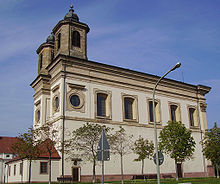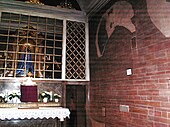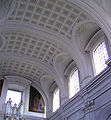Pilgrimage Church of the Assumption of Mary (Ludwigshafen)
The palace and pilgrimage church of the Assumption of Mary in the Ludwigshafen district of Oggersheim (state of Rhineland-Palatinate ) is a catholic hall church in the early classicist style , which also has high baroque elements. It was built in 1775 over a Loreto chapel that had existed since 1729 and was completely preserved. The address is Kapellengasse 8.
history
Origins of the Loreto pilgrimage
The Loreto pilgrimage is based on the veneration of the Holy Family , whose house, the Casa sancta , according to legend, was carried by angels from Nazareth when the Holy Land fell to Islam in 1263 . In 1554 the Jesuits in Loreto ( central Italy ) propagated the cult of the Holy House , which was equated with the Loreto Chapel. As a result, replicas of the Loreto Chapel with their own pilgrimages were made in many countries.
Construction of the Loreto Chapel in Oggersheim
In Oggersheim, Count Palatine and Hereditary Prince Joseph Karl von Pfalz-Sulzbach had a pleasure palace with a park built from a branch line of the Wittelsbach family (1694–1729) from 1720 onwards. In this park he also had a baroque Loreto chapel built in 1729 , as the veneration of Mary in the Wittelsbach house traditionally had a high priority. The building, the cornerstone of which he laid himself, was an exact imitation of the original chapel in Loreto, Italy, where he also ordered a copy of the miraculous image there , a Black Madonna . This was kept for one night with the original image of grace and brought into contact with it. Even the architectural irregularities of the model were adopted in Oggersheim and the wall paintings (which were no longer fully preserved in the 18th century) were copied from Italy. In addition, Joseph Karl tried by Pope Benedict XIII. obtain various indulgences and relics . The Wittelsbacher had probably received the suggestion for the construction in the Cologne monastery of St. Maria in the Kupfergasse , where his aunt Amalia Maria Therese von Pfalz-Sulzbach (1651–1721) and his older sister Maria Anna von Pfalz-Sulzbach (1693–1762) When Discalced Carmelites lived and where there had been a Loreto chapel with a miraculous image for a long time. However, the Count Palatine died on July 18, 1729, before his foundation could be completed and the palace complex became orphaned.
The chapel continued to receive funding, since Elector Karl III. Philip wished to resume the Lauretanian worship "for the general benefit and consolation of the fatherland" . On October 14, 1730, he sent the hermit Johann Adam Hauer to the chapel as pastor and was supposed to receive official support. However, there is no evidence of his activity in Oggersheim, so it is not known whether he ever held his office.
Jesuit care of the chapel
On March 1, 1733, the chapel was handed over to the Mannheim Jesuits for care. On behalf of the electoral prince, the image of grace donated by the Wittelsbach house was transferred to the Loreto Chapel on the Annunciation (March 25) and the Madonna of Oggersheim was declared the patroness of the Electoral Palatinate. On that occasion, a silver medal was struck with the image of grace and the view of the chapel, the inscription of which describes the Madonna of Loreto as the patroness of the Electoral Palatinate. This opened the Oggersheim pilgrimage and soon enjoyed widespread popularity among the population. Elector Karl III. Philipp was one of her most ardent supporters and often distinguished her with his personal presence.
Father Matthäus Vogel SJ from Mannheim took special care of the pilgrimage site, wrote a booklet about it in 1741 and became the first leader of the pilgrimage. He worked here from 1733 until his death in Oggersheim on November 2, 1766. Due to the princely patronage and many answers to prayer, the Loreto Chapel became more and more famous and the target of processions from all over the area. Thanks to numerous foundations and generous financial support from Count Palatine Friedrich Michael von Pfalz-Birkenfeld , son-in-law of the builder of the Oggersheim Chapel, the Jesuits were able to establish a permanent establishment in Oggersheim to look after the pilgrims, which they moved into on May 15, 1761. On this occasion, Elector Karl Theodor founded a mission in 1760, which was occupied by Matthäus Vogel, two other Mannheim Jesuits and a lay brother. In his little book, Vogel wrote about the intention of the foundation:
“ The beautiful example of so many Christian countries ... the desire to see God the Lord in his St. To praise mother and to expand the honor of the most precious Queen of Heaven in these lands as well as to receive various graces from heaven for her intercession, Count Palatine Joseph Karl, Hereditary Prince of the Duchy of Sulzbach, induced a form of St. To erect a chapel designed in the house of Loreto. "
Electoral sponsorship
The pilgrimage site was also supported by the example of Electress Elisabeth Auguste . She regularly visited the chapel, and her husband Carl Theodor waived all those who went to the Oggersheim Chapel on Marian festivals to pay the bridge toll over the Mannheim ship bridge. The pilgrimage increased when the seriously ill elector recovered miraculously in 1743 after the elector had a novena (nine-day prayer) held in the Loreto Chapel . In gratitude for the healing, the prince had the interior of the chapel redesigned.
Even before the birth of the heir to the throne , the couple turned to the Mother of God, but the child died in 1761, only one day old. Although Elector Carl Theodor turned away from his wife in the following years, when her husband fell ill again in 1774, she had a procession held to Oggersheim.
From 1768 to 1793, Electress Elisabeth Augusta lived mostly separately from her husband, in Oggersheim Castle opposite the Loreto Chapel. According to the inscription above the main portal, it had the Flemish architect Peter Anton von Verschaffelt built over it with today's pilgrimage church in 1775 , with the chapel remaining completely intact, albeit clad with colored marble. The work lasted from 1774 to 1777 and was realized through compulsory service (or sometimes money instead) of the communities.
After the abolition of the Jesuit order
The church was consecrated on October 18, 1777, but was now supplied by Capuchin fathers, as the Jesuit order previously active here had been abolished in 1773. Friedrich Matthisson writes about his visit to Oggersheim:
“ My departure from Mannheim (1786) was postponed by eight full days past the determined point of intersection. But in the end the necessity asserted its old right to despots, and so on the very day when the theater bill announced Iffland as Franz Moor , a sullen wage-driver had to drive me to Oggersheim at the slowest pace. - The Electress was in fact very well advised, since she chose this cheerful and clean place as her usual residence. The Hofkapelle (pilgrimage church) in Oggersheim does every possible honor to its reputation of being one of the most flawless architectural works in the Palatinate. Let the art devoted illuminate the graceful building with a Vitruvian lamp; I am a layperson was given the lively pleasure that always arises from its form and correct relationship. "
At the end of 1793 the Electress fled from the approaching French revolutionary troops to Weinheim , where she from then on lived in the castle there . In 1798 the Capuchins were also expelled from Oggersheim. The pilgrimage church lost its status as a court church and was taken over by the local parish. From 1798 to 1804, for political reasons, pilgrims also had to stop. Only the church-friendly King Ludwig I of Bavaria reestablished religious life in Oggersheim when Pastor Henkes died in 1843 and the population asked for a new monastery to be founded. On April 21, 1844, Ludwig founded a convent of the Franciscan Minorites from private funds , which still exists today and takes care of the pilgrimage. The costs of the monastery were covered by the income of a foundation of 80,000 guilders. This enabled the pilgrimages to be looked after more intensively again and, especially from the 1980s onwards, took off. In 1984 and 1988 the church was renovated, although the style features of the 18th century were taken into account. In 1993, the members of the Würzburg Order Province had to hand over the monastery to the Minorites from Krakow due to a lack of staff, five of whom are monks in Oggersheim today.
Buildings and furnishings
chapel
The interior of the chapel was covered with a barrel vault and divided in two by a grille. The altar of the Chapel of Mercy stands in front of the lattice, the rear, narrower part of the room is intended for the miraculous image of the Blessed Mother , which is located in a niche. Like the two angels attached to its side, this was designed by the Mannheim court sculptor Paul Egell around 1740 . As in all Loreto chapels, the walls are formed according to the wall structure of the original Holy House. In the chapel, next to some votive tablets, there is also a wood carving by Anna Selbdritt, which dates from the 16th century and was made in the Middle Rhine region .
church
The outer facade with its composite capitals is reminiscent of that of a temple and is based on the style of Carlo Rainaldi . The working materials were mainly plaster and sandstone . On the south-western outer wall there are two single-storey towers with domed roofs , opposite on the side of the entrance a triangular gable . The interior wall of the church consists of Corinthian pilasters and flat wall niches . The ceiling is formed by a barrel vault with stucco coffers , the windows are arched windows .
The wide, single-nave room follows the rectangular floor plan of the Loreto Chapel and, like this, faces southwest, where the choir is also located. The nave takes up the Loreto chapel completely. Its north-eastern outer wall also forms the rear wall of the high altar of the large pilgrimage church. This was made according to designs by the architect Peter Anton von Verschaffelt , the altar paintings are by Georg Oswald May . To the side of the altar are two console tables , which were possibly designed by Paul Egell around 1725 and which could have come from the Oggersheim Castle. There are two smaller altars on the sides, and the church also has a pulpit, a baptismal font, confessionals and an organ gallery. Several organ prospectuses from the time the church was built have been preserved.
organ
The organ was manufactured by the Mayer company from Heusweiler and has the following technical data:
- Wind pressure: HW 70 mm WS; RP 60 mm WS; Ped 75 mm WS
- Coupling (electromech.): RP / HW - HW / P - RP / P
- Register : 24 with 1761 pipes and 3 transmissions
- Action action: mechanical
- Stop action : mechanical and electrical; 16-fold electrical setter combination
Pilgrimage
The church's pilgrimage days are Candlemas (February 2 ), St. Joseph's Day (March 19), Annunciation (March 25), Visitation (May 31), Assumption (main pilgrimage day, August 14/15), and Mary Birth (September 8th), St. Elizabeth (September 23rd) and Immaculate Conception (December 8th).
Picture gallery
literature
- Martin Josef Mörschell: History of Oggersheim and the newly founded Minorite monastery there . Self-published, 1844, p. 35 ( scan from the source ).
- Karl Anton Kreuter : Festschrift for the 150th anniversary of the parish and pilgrimage church in Oggersheim. Catholic rectory in Oggersheim, 1925.
- Dehio / Gall Handbook of German Art Monuments . Palatinate and Rheinhessen. 2nd edition, Deutscher Kunstverlag, Munich / Berlin 1961, p. 257 (brief description of the building).
- 200 years of the parish and pilgrimage church Maria Himmelfahrt, Ludwigshafen – Oggersheim. 3rd amend. Edition. Parish councilor Maria Himmelfahrt, Ludwigshafen – Oggersheim 1977.
- August Gutzer: Oggersheim and the Jesuits. Catalog for the exhibition in the Schillerhaus. Local history study group Lu-Oggersheim, 1983.
- Jürgen Kaiser: Ludwigshafen – Oggersheim, pilgrimage church of the Assumption. 2. edit again Edition, Schnell and Steiner, Regensburg 2002.
Web links
- The history of the Minorite monastery in Ludwigshafen-Oggersheim
- Website of the Diocese of Speyer on the Oggersheim pilgrimage
- Cultural monuments in Ludwigshafen
- 225 years of pilgrimage church Maria Himmelfahrt: Fixed castle in the storm of time ( Memento from September 6, 2008 in the Internet Archive )
- Pilgrimage Church of the Assumption of Mary and the associated Minorite Monastery (with photos of the church)
- The Catholic pilgrimage church of the Assumption on regionalgeschichte.net
- Bells of the pilgrimage church of the Assumption
Individual evidence
- ^ Franz Weckesser: 200 years of Oggersheimer pilgrimage , in: Die Pfalz am Rhein , born 1933, p. 313 u. 314 (with illustration of the medal)
Coordinates: 49 ° 29 ′ 24.2 " N , 8 ° 22 ′ 37.2" E














